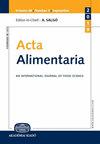不同壁材及包封工艺对橄榄叶提取物微胶囊化的影响
IF 1
4区 农林科学
Q4 FOOD SCIENCE & TECHNOLOGY
引用次数: 0
摘要
在本研究中,它旨在封装橄榄叶的一些功能成分。以海藻酸钠、海藻酸/明胶和海藻酸盐/琼脂溶液为壁材,采用离子凝胶技术对橄榄叶提取物进行了包封。以明胶溶液为壁材,采用冷凝胶技术对橄榄叶提取物进行包封。对研究中使用的涂层材料的粘度进行了研究。进行优化过程以确定离子凝胶化技术中应用的注射时间,并确定所获得胶囊的包封效率、粒径、溶胀率、体外释放特性和抗氧化活性。虽然通过冷凝胶化技术获得的胶囊的包封效率最高(98.2±0.99%),但表明离子凝胶化技术中使用的壁材料的粘度对包封效率很重要。使用冷凝胶技术获得的胶囊的粒径和溶胀率最高。油尿蛋白在胃pH值下的释放速率通常高于在肠pH值下。抗氧化活性与胶囊的包封效率之间存在相关性。本文章由计算机程序翻译,如有差异,请以英文原文为准。
Investigation of the effects of some wall materials and encapsulation techniques on the microencapsulation of olive leaf extract
In this study, it is aimed to encapsulate some functional components of the olive leaves. Olive leaf extract was encapsulated using solution of sodium alginate, sodium alginate/gelatine, and sodium alginate/agar as wall material by ionic gelation technique. Also, olive leaf extract was encapsulated using solution of gelatine as wall material by cold gelation technique. The viscosities of the coating materials used in the study were investigated. An optimisation process was carried out to determine the injection time to be applied in the ionic gelation technique and the encapsulation efficiencies, particle sizes, swelling ratios, in vitro release profiles, and antioxidant activities of the obtained capsules were determined. While the encapsulation efficiency of the capsules obtained by the cold gelation technique was determined as the highest (98.2 ± 0.99%), it was revealed that the viscosity of the wall material used in the ionic gelation technique was important in the encapsulation efficiency. The particle size and swelling rate of the capsules obtained using the cold gelation technique were the highest. The release rate of oleuropein was generally higher at gastric pH than at intestinal pH. A correlation was found between antioxidant activities and the encapsulation efficiency of capsules.
求助全文
通过发布文献求助,成功后即可免费获取论文全文。
去求助
来源期刊

Acta Alimentaria
农林科学-食品科技
CiteScore
1.80
自引率
0.00%
发文量
47
审稿时长
18-36 weeks
期刊介绍:
Acta Alimentaria publishes original papers and reviews on food science (physics, physical chemistry, chemistry, analysis, biology, microbiology, enzymology, engineering, instrumentation, automation and economics of foods, food production and food technology, food quality, post-harvest treatments, food safety and nutrition).
 求助内容:
求助内容: 应助结果提醒方式:
应助结果提醒方式:


